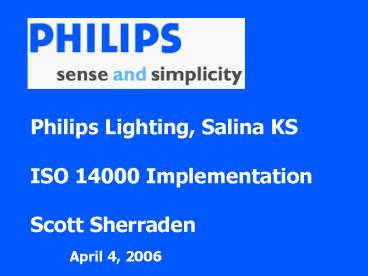Philips Lighting, Salina KS ISO 14000 Implementation Scott Sherraden - PowerPoint PPT Presentation
1 / 36
Title: Philips Lighting, Salina KS ISO 14000 Implementation Scott Sherraden
1
Philips Lighting, Salina KSISO 14000
ImplementationScott Sherraden
April 4, 2006
2
Philips Lighting - Salina, KS
3
- LAND AREA 160 Acres
- ORGINAL PLANT 1966
- CONSTRUCTION 436,000 Sq. Ft.
- 10 acres
- CURRENT TOTAL 795,080 Sq. Ft.
- 18 acres
4
Different Lamp Types Sizes
T12
T8
Base Types Bi-Pin, R17D Single Pin
5
Salina Lamp Products
Various lengths for lamp types F20, F30, F40,
F48 F72
6
AGENDA ISO 14001 at Philips Lighting Program
History and Certification Environmental Policy
and EMS Regulations and compliance
tracking Objectives and Targets Projects and
Benefits QUESTIONS
7
Why focus on Sustainability?
- SUSTAINABILITY is defined as
- meeting the needs of the present generation
without compromising the ability of future
generations to meet their own needs
We recognize the need to perform not only
against a single, financial bottom line, but
against a triple bottom line involving economic
prosperity, environmental quality and social
equity Gerard Kleisterlee President CEO of
Royal Philips Electronics
2
8
Why focus on Sustainability?
ECONOMIC RESPONSIBILITY
SOCIAL RESPONSIBILITY
ENVIRONMENTAL RESPONSIBILITY
9
(No Transcript)
10
(No Transcript)
11
- Salina ISO 14000 Program History and
Certification
- Philips sustainability target was for all
manufacturing locations to be ISO14000 Certified.
- Salina achieved KEMA certification on May 1,
2000. - However, many months of work and planning were
completed prior to that. - A plant team worked with SBEA/PPI for ISO
certification, including aspects/impacts and
drafting an EMS and policy statement.
12
ISO Certification
- ISO 9001 Certified (KEMA)
- ISO 14001 Certified (KEMA)
13
- Environmental Policy and EMS
14
What does an EMS do for Philips?
- Helps manage Environmental Aspects of the
organization. - Demonstrates commitment to prevention of
pollution continual improvement. - Supports our corporate Sustainability objectives.
15
How do employees access the EMS?
- It is critical that employees can access the
EMS routinely for work instructions. - Documentation must be well controlled (updated).
- We started out with green folders located in
the plant. - Recently we moved to an online specification
system.
16
Plant Environmental Instructions(green folders)
These are located through out the plant with the
Process Specifications.
17
Plant Environmental Instructions(online
specifications)
18
Hazardous Waste Storage Areas
- Individual areas where waste is generated and
gathered in a container is a satellite area. - When containers are full and sealed they must be
dated and moved within three days from the
satellite area. - Full containers of hazardous waste are kept in
one of two storage areas the Hazardous Waste
storage building outside and the 90-day Hazardous
Waste Accumulation area East of the Quality
Department.
19
Hazardous Waste Streams
AEROSOL CANS
Before any aerosol can is disposed of in the
trash it must be RCRA empty. This means the
inside of the can must be at atmospheric pressure
and less than 3 of the contents remain inside
the can. Any cans that are not RCRA empty must
be discarded in the drum marked Discarded
Aerosol Cans located in the Oil Bay.
20
Non-Hazardous Waste Used Oil
Used oil is recycled. Used oil is place in a
translucent tote. If a drum must be used it is to
be MARKED AS USED OIL. Drums need to have 4 of
space when full and full drums are to be moved to
the Hazardous Waste building.
21
Regulations and compliance tracking
- Attend workshops and conferences
- Maintain a log of reporting dates and
requirements - Peer audits for compliance (internal)
- External agency audits
- These are all addressed in our EMS
22
Objectives and Targets EcoVision
23
EcoVision 2002 - 2005
24
Projects and Benefits
25
Previous Ecovision Projects
Base Cement Scrap Reduction Water based solvents
(shop, fixture room) Gas-Oxy Furnace (energy
reduction) Shrinkage reduction Coating millroom
centrifuge Water usage reductions Packaging
reductions
26
Future Ecovision Projects
Lamp Recycling (reuse our scrap glass in
furnace) Low Mass Glass Johnson Controls Energy
Audit Process Heat Recovery
27
Example Project Water Based Parts Cleaning
Solvent (WASTE reduction)
28
Problems with Previous Cleaning Method
- Parts cleaning is time consuming
- Solvents do not effectively remove all dirt and
buildup - Bead blasting is required which causes premature
wear
29
Problems with previous Flammable Solvents
- Solvents generated 12,000 pounds of hazardous
waste annually - Annual Cost for solvent disposal was 43,200
- The Fixture Room accounts for 80 of the solvent
usage in the plant - Flammable Solvents are NOT SUSTAINABLE
30
Philips EcoVision 2002-2005
EcoVision is a Philips wide environmental
reporting and benchmarking tool for our
shareholders
Mandatory Target of 20 Reduction in Waste!
31
Define New Cleaning Methods
- We studied various methods
- Tumbling
- Water based solvents
- Elimination of hazardous waste was a key factor
32
Cleaning Methods
- A new water-based spray cabinet system was
successfully tested on-site
33
Cleaning Methods
- A water based parts washer for scrubbing small
parts was also installed in the fixture room
34
Water Based Spray Cabinet
SOLVENT BASED CLEANER
WATER BASED SPRAY CABINET
BEFORE
AFTER
35
EcoVision Waste Reduction Results
- 90 reduction of FLAMMABLE SOLVENTS in the plant
- Reduction in Hazardous Waste of 10,800 lbs/year
- Bonus Safety Improvement by reducing flammables!
36
QUESTIONS?































